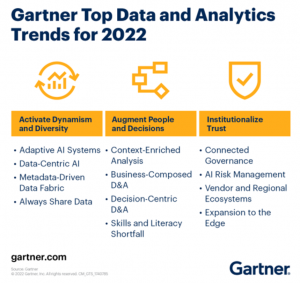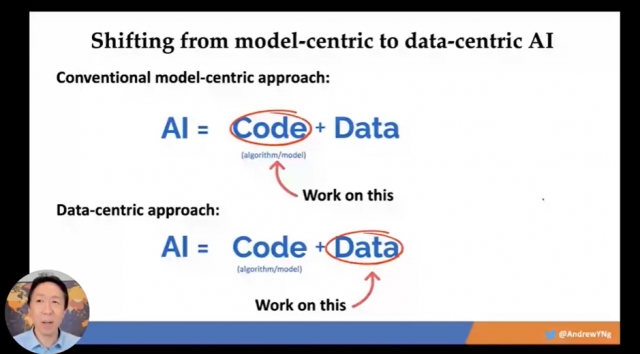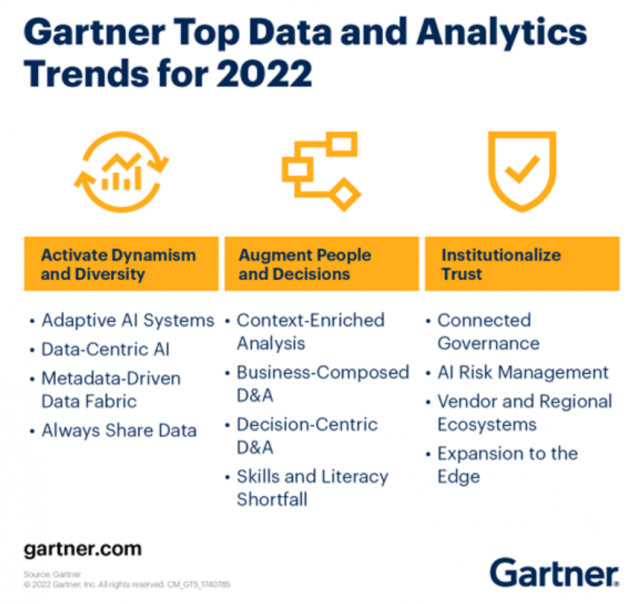
Every year, Gartner releases a report on the latest data analytics trends that will be influential for businesses in the coming year. These reports are always insightful, and provide valuable information for companies who want to stay ahead of the curve. This year is no exception, and Gartner released their predictions for data analytics trends in earlier in 2022. In this blog post, we will take a look at some of the most important trends that Gartner has identified. Although it is a bit late to publish this post. However, this post discusses the concepts in detail and will be updated from time-to-time. Stay tuned for more insights into the world of data analytics!
Gartner Data Analytics Trends
The following picture represents the Gartner data analytics trends for 2022. This will be discussed in detail in this post.
The following are three different themes for 2022 data analytics trends published by Gartner earlier this year:
- Adaptive dynamism & diversity
- Augment people & decisions
- Institutionalize trust
Adaptive Dynamism & Diversity
Adaptive dynamism and diversity is about being able to rapidly adapt to change while maintaining a sense of stability. This is especially important in the world of data analytics, where change is constant and the landscape is always shifting. Businesses need to be able to quickly adapt their strategies and processes in order to stay ahead of the competition. The following are some of the key focus areas in relation to adopting and adapting to dynamic and diverse business needs:
- Adaptive AI systems: Adaptive AI systems are computer systems that can change their behavior in response to new data or new circumstances. This type of AI system is often used in applications where the environment is constantly changing, such as in autonomous vehicles or robots. Adaptive AI systems are typically able to learn and improve over time, making them well-suited for applications where traditional AI systems might fail. One advantage of adaptive AI systems is that they can often be more efficient than traditional AI systems, since they only need to learn the information that is relevant to their current task. Additionally, adaptive AI systems can be more robust than traditional AI systems, as they are less likely to be impacted by changes in the environment. While adaptive AI systems have many advantages, one challenge that must be overcome is designing systems that are capable of learning from a wide range of data sources. Another challenge is ensuring that the system does not become overloaded with information and lose its ability to adapt.
- Data-centric AI: Data-centric AI is about moving from having primary focus on building models using machine learning algorithms to having primary focus on getting right kind of data which can be used to build high-performing models. The picture below is taken on Andrew NG presentation which does represent the difference between model-centric and data-centric AI.

Until few years back, it was a challenge to get the model right. However, that has been solved to a great extent for common problems. We have AutoML libraries, a ton of open-source AI / ML projects on GitHub, and cloud ML services from AWS, Google, Azure, etc. using which one can easily build models having decent enough performance. What still remains as a challenge is to get right quality and volume of data. This is where the focus on data-centric AI comes into picture. Check out the following video to understand about data-centric AI.
- Metadata-driven data fabric: Data fabric is a term used to describe a network of interconnected data resources that can be used to support a range of business activities. At its most basic, a data fabric can be thought of as a digital version of a traditional fabric, such as cloth or paper. Just as a physical fabric can be used to create a wide variety of products, so too can a data fabric be used to create a wide variety of business applications. Data fabrics are often used to create customized applications that can be deployed across an organization. This helps to ensure that the data is consistently formatted and easy to access, regardless of where it is stored. Data fabrics are also commonly used to integrate disparate data sources, such as databases, applications, and web services. By integrating these data sources, organizations can more easily share information and collaborate on projects.
- Always share data
Augment People & Decisions
One of the key objective of data and analytics in current times is to deliver business value/impact by leveraging data, analytics and people expertise to make right decisions. The following are key focus areas in this relation:
- Context enriched analysis
- Business composed data analytics
- Decision centric data analytics
- Skills & literacy shortfall
Lets understand each of the above focus areas in detail.
- Context enriched analysis: Context enriched analysis is a data analytics approach that incorporates contextual information into the analysis in order to improve its accuracy and relevance. The idea is that by understanding the context in which data was collected, analysts can better interpret its meaning and identify patterns that would otherwise be hidden. Contextual information can include anything from the location of a data point to the time of day it was collected. Context enriched analysis is often used in fields such as marketing, where understanding customer behavior is essential to making effective decisions. According to Gartner, context enriched analysis will become increasingly important in the coming years as the volume and variety of data continue to grow.
- Business-composed data analytics: Business composed data analytics is the process of building packaged business capabilities (PBC) related to data and analytics with a goal to deliver valuable insights in an agile manner to improve business operations. Analytics packaged business capabilities is about delivering insights by leveraging packaged capabilities in form of traditional BI dashboards, self-service analytics, predictive modeling, prescriptive modeling, reports, etc. Data PBC is about building capabilities around getting quick access to data through data fabric layer. Data fabric layer is an abstract layer of software that hides the complexity of data management from users and applications. Data PBC will help you get to insights faster by leveraging existing analytics capabilities
- Decision-centric data analytics: Decision centric data analytics is an approach to data analytics that focuses on making better decisions, rather than simply understanding what has happened in the past. The idea is that by understanding the factors that influence decision-making, analysts can provide more accurate and relevant insights. Gartner estimates that by 2023, more than 33% of large organizations will have analysts practicing decision intelligence, including decision modeling. Decision intelligence can be defined as a set of processes and methods used to understand how humans make decisions, and how those decisions can be improved. The two key aspects of decision intelligence is how to ensure/monitor that good decisions are made, and, how the decisions are made. Data analytics play key role in both these aspects. Here is a great video on how decision intelligence can impact business outcomes.
- Skills & literacy shortage: Skills and data literacy shortfall is a Gartner identified Top 12 Data and Analytics Strategy Trend for 2022. As per Gartner, by 2024, 50% of enterprises will have a data literacy program, compared with 20% in 2020. The skills shortage is not just about finding people with the right technical skills, but also about finding people who understand how to use data to make decisions. Data literacy is the ability to read, write and communicate data in a way that it can be understood by others. It also includes the ability to understand and use statistical techniques to analyze data. Gartner predicts that the demand for data literacy will continue to grow in the coming years as organizations increasingly rely on data to make decisions.
Institutionalize Trust
One of the key pillars of data-driven culture is the trust on data and analytics as an effective business lever among the associates in the organization. The following can be focus areas in relation to institutionalizing trust on data analytics capabilities across the organization:
- Connected governance: The goal is to have governance within the business unit to address the operational challenges in a timely manner and also, connected business units and changing external market. Data analytics can be leveraged to gather and analyze the data from different business units and market intelligence.
- AI risk management
- Vendor and regional ecosystems
- Expansion to the edge
References
Gartner has outlined five key data and analytics trends that will be important in the coming years. These trends include business-composed data analytics, decision-centric data analytics, skills and literacy shortfall, institutionalize trust, and expansion to the edge. Each of these trends is important in its own right, and businesses should begin preparing for them now if they want to stay ahead of the curve. Gartner’s predictions are based on extensive research into the field of data and analytics, so businesses would do well to heed their advice.
- Coefficient of Variation in Regression Modelling: Example - November 9, 2025
- Chunking Strategies for RAG with Examples - November 2, 2025
- RAG Pipeline: 6 Steps for Creating Naive RAG App - November 1, 2025

I found it very helpful. However the differences are not too understandable for me